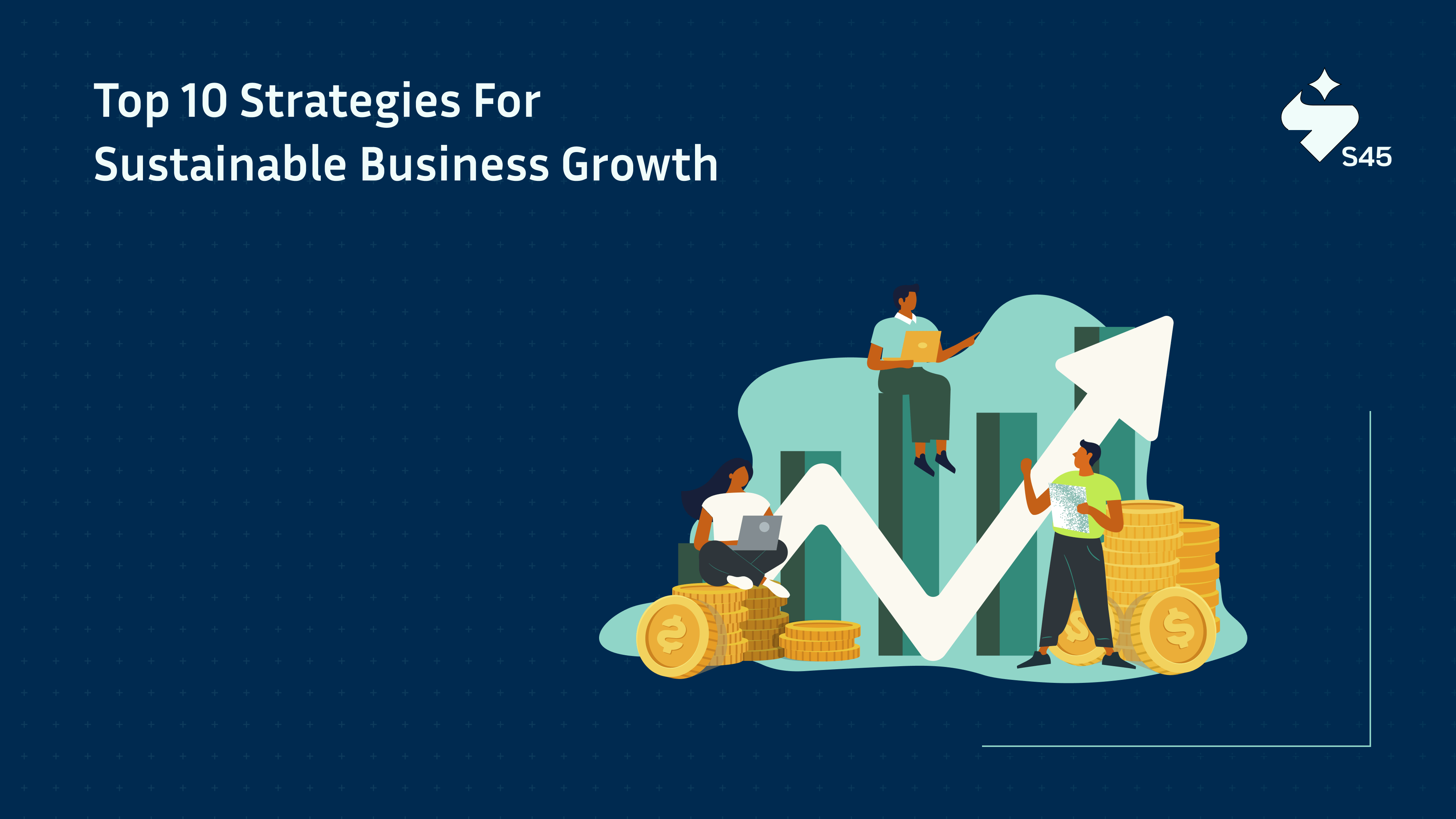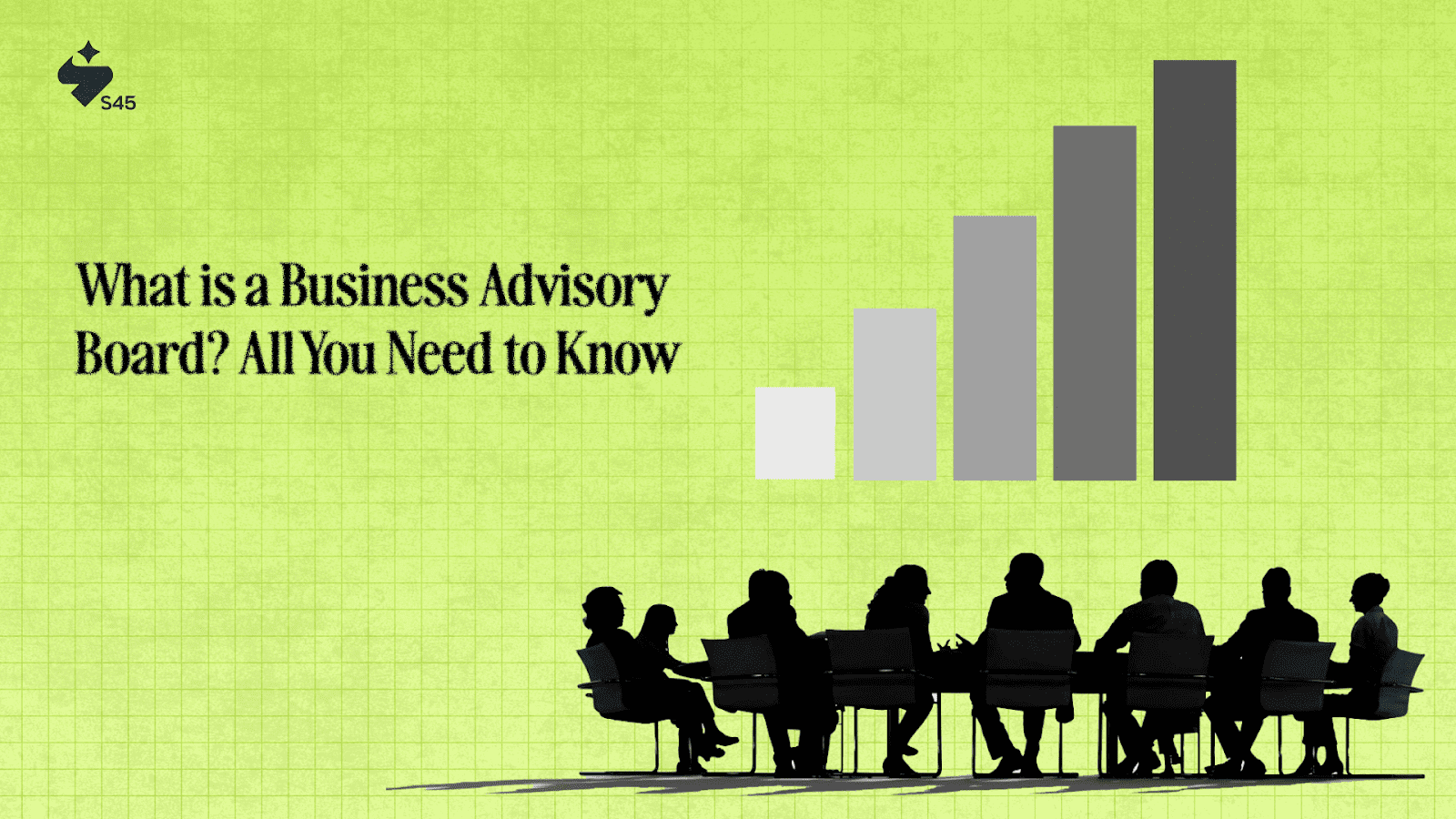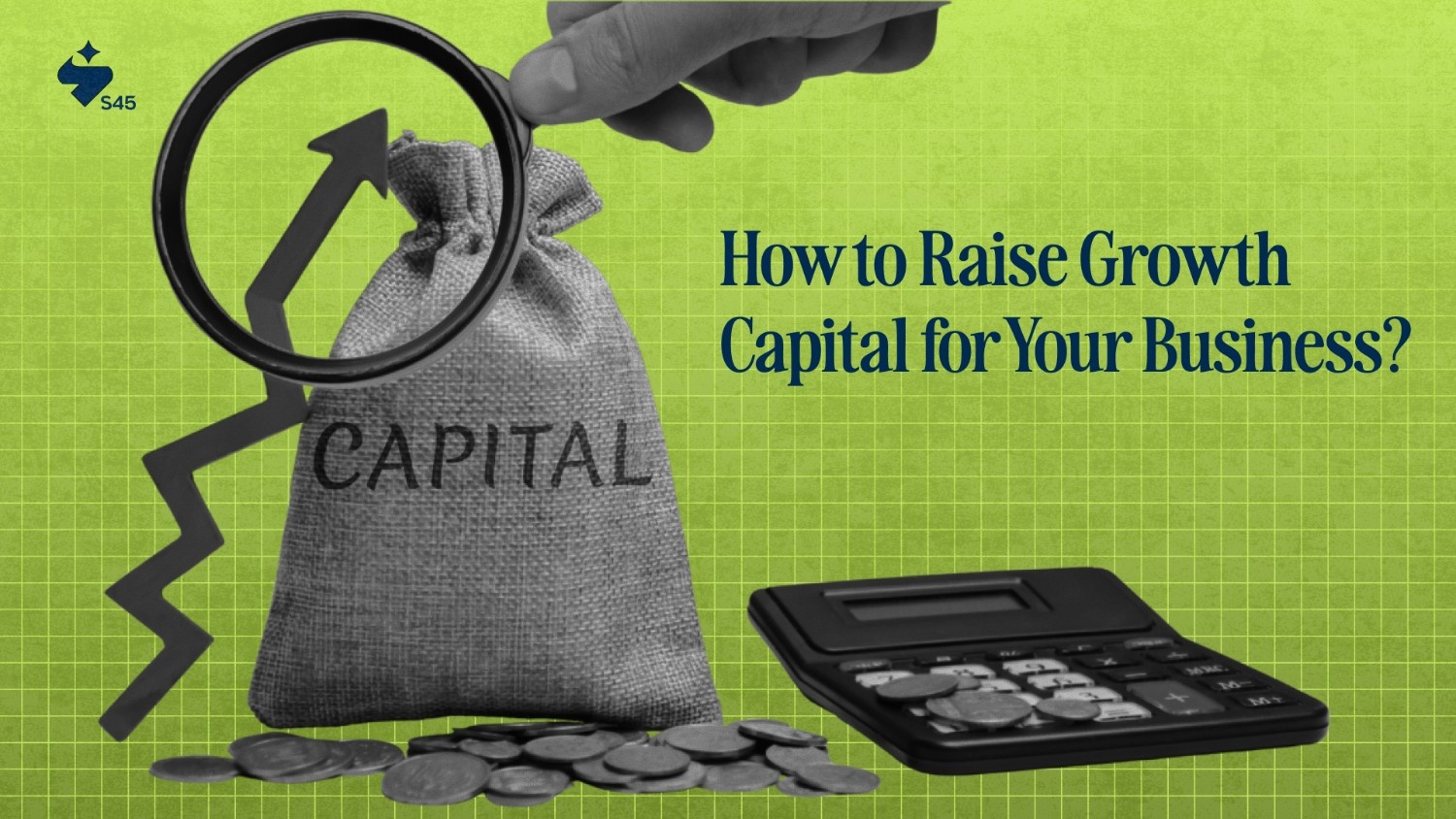
According to you, what does true business growth and sustainability really mean, beyond mere revenue figures? In India, 93 % of manufacturers are now adopting sustainability through Industry 5.0, aiming to achieve 2-3x profitable growth in the coming years. Yet, many mid-market manufacturing firms and family-run trading houses struggle to scale without eroding their core values or over utilizing finances.
The challenge lies in achieving business growth and sustainability while ensuring that each step forward strengthens the foundation rather than undermines it. Growth is a goal worth pursuing; with the right path, partners, and preparation, it becomes both achievable and enduring.
In this guide, you will learn the top sustainable business growth strategies. It will help you strike the balance between legacy and innovation, ensuring each expansion step is meaningful and lasting for founders aiming for sustainable business growth in India's evolving ecosystem.
TL;DR (Key Takeaways)
- Sustainable growth combines profit with long-term stability.
- Strong leadership and a clear purpose drives business success.
- Innovation and operational efficiency support sustainable scaling.
- Building people-focused cultures ensures resilience and adaptability.
- Partnerships and equity funding enable growth without risking business foundations.
How Long Does It Take to Attain Business Growth and Sustainability?
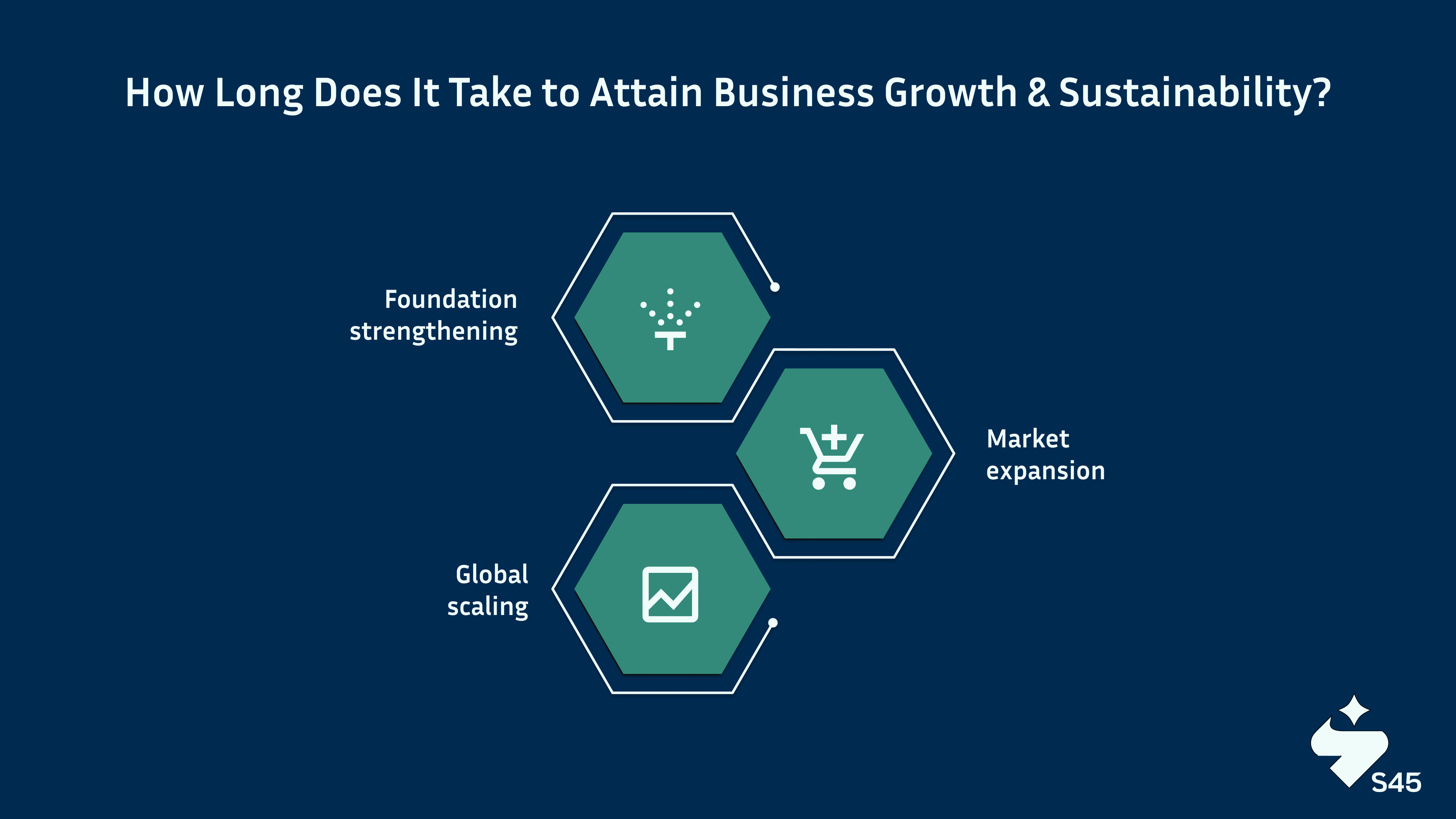
There is no universal timeline for business growth and sustainability. It depends on your sector, business size, ambition, and market dynamics.
For most mid-market manufacturing businesses in India, it typically takes 3 to 5 years to scale up profitably while preserving what matters, such as legacy, values, and operational stability.
Typically, sustainable growth happens in phases:
- Foundation strengthening: Optimizing processes, developing strong leadership, and improving financial discipline.
- Market expansion: Entering new geographies or customer segments, refining your B2B sales outreach, and enhancing product offerings.
- Global scaling: Establishing international supply chains, adopting advanced technologies, and positioning your brand in global markets.
Trying to move too fast, whether through excessive debt or by skipping over key operational gaps, can cause instability and break trust with teams and customers. While shortcuts may seem tempting, they often lead to setbacks rather than lasting progress.
Sustainable growth requires patience, preparation, and trusted partners who understand your vision and help you build from the ground up. When these elements come together, growth and sustainability support each other, creating a business that's built to last.
This brings us to a crucial consideration for any growing business: finding the right balance between rapid growth and long-term sustainability.
The Balance Between Growth and Sustainability
So, what does sustainable growth actually look like for traditional businesses? At its core, it means expanding without losing the core strengths that built your foundation. For many manufacturing and trading firms, growth and sustainability are not separate goals. They need to go hand in hand.
Balancing growth and sustainability requires:
- Innovation with legacy: Modernizing operations while respecting family values, craftsmanship, and long-standing supplier relationships.
- Speed with stability: Rapid expansion is tempting, but it must not compromize financial health or operational discipline.
- Short-term wins with long-term health: Winning a large contract is great, but ensuring your systems and teams can handle it is equally crucial.
Think of it like climbing a steep mountain. Scaling too fast without anchoring can make you lose footing on the climb. The same applies to business. Growth without stability often leads to operational breakdowns, loss of brand trust, and demotivated teams.
The sustainable growth of business is not just about adding revenue streams; it is about building a company that thrives across generations. By adhering to these principles, founders can ensure that the growth of a sustainable business is genuinely sustainable.
To make this balance practical, let's understand the strategies that combine ambition with thoughtful execution for your journey ahead.
Top 10 Strategies for Business Growth and Sustainability
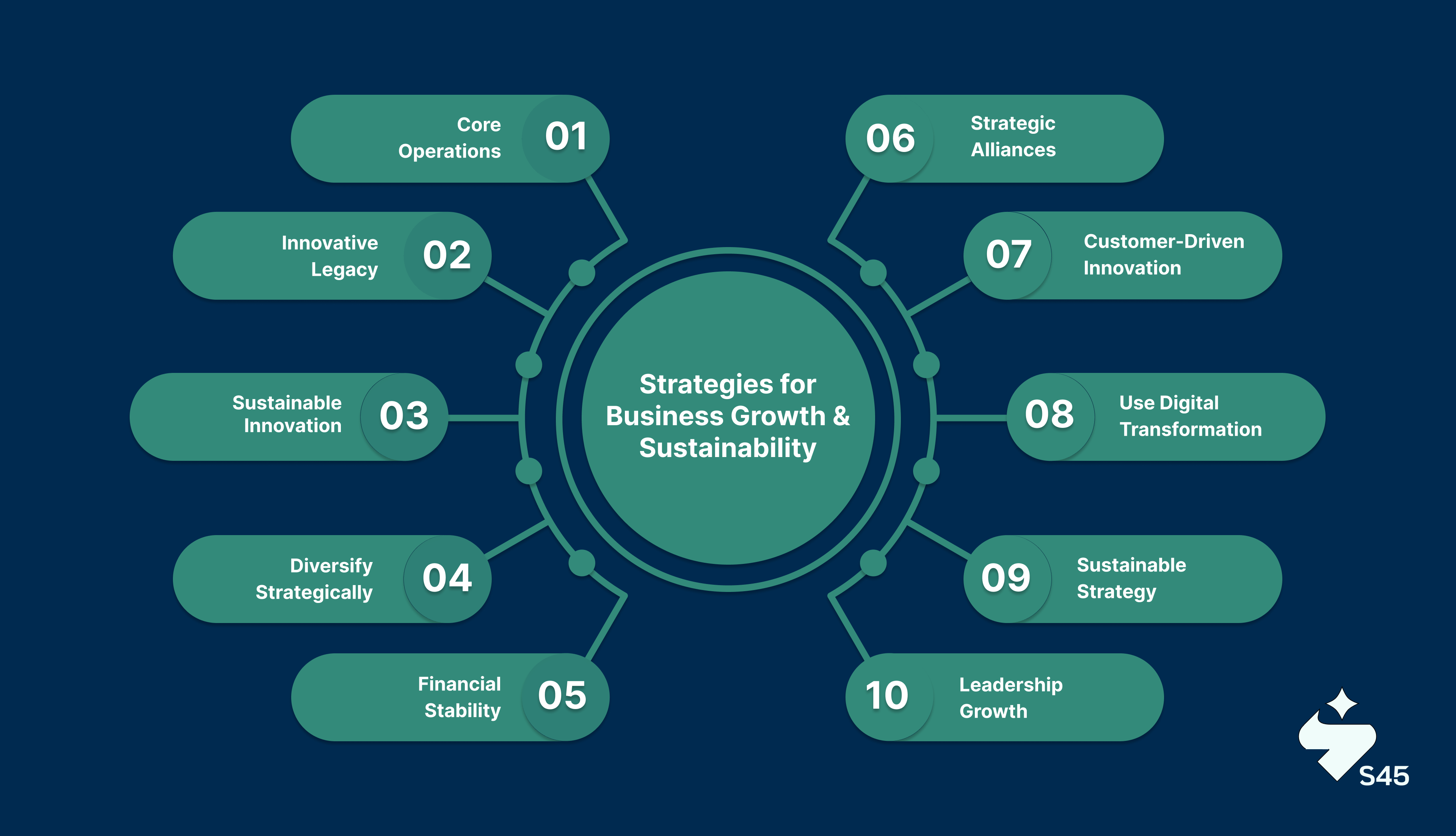
Business growth and sustainability are not achieved overnight. They demand careful planning, strong execution, and clear principles. Each step you take should build upon the last, strengthening your foundation while opening new paths.
Below are the top 10 sustainable business growth strategies that will guide your journey. Think of them as routes that lead you to the summit while keeping your base strong and steady.
1. Strengthen Your Core Operations First
Before thinking about scaling, it’s essential to optimize what’s already in place. Efficient internal processes reduce costs, improve product or service quality, and create the foundation for sustainable growth.
For example, adopting lean manufacturing can minimize waste without affecting output. Similarly, digitizing your supply chain brings greater transparency and enables quicker responses to shifting market demands.
Think of it like climbing a mountain. Without securing your base camp, every step forward carries unnecessary risk. The same principle applies to your business. Strengthening core operations ensures that each stage of growth is built on a stable, efficient framework.
Start by reviewing existing workflows, spotting areas of delay or friction, and investing in process automation. Eliminating inefficiencies now will help your business scale with confidence and resilience.
2. Cultivate a Culture of Innovation Anchored in Legacy
Your people are your greatest asset. Training, upskilling, and leadership development build resilience in your team. When your climbers are skilled, your journey is safer and faster. Encourage innovation but keep it rooted in your company's legacy.
For example, train teams to adopt new tools while valuing traditional craftsmanship. Come over resistance by communicating how innovation enhances their skills, secures jobs, and preserves your legacy while driving growth.
3. Access Innovation Without Losing Footprint
Modernizing operations does not mean erasing what makes your business special. Many family-run trading houses now use digital inventory systems while keeping their personalised customer service intact.
It is sustainable business growth using innovation to enhance your legacy, not replace it. You can adopt technologies that integrate with your values and communicate their purpose clearly to your teams.
4. Diversify Strategically
Entering new markets or product lines can boost revenue, but only when aligned with your strengths. Diversification for its own sake often weakens focus. Choose new routes connected to your existing base.
For instance, a textile manufacturer might expand into technical fabrics. This area relates to its core expertise, unlike branching into an unrelated industry. Before diversifying, assess your capabilities, market demand, and the strength of customer relationships to ensure both growth and long-term sustainability.
5. Build Strong Financial Foundations
Healthy finances are critical for the sustainable growth of business. Manage debt wisely, improve cash flows, and plan capital expenditure carefully. Avoid shortcuts like excessive borrowing for rapid expansion.
Instead, build reserves that support strategic growth investments. Conquer challenges by working with financial advisors to track ratios, optimize working capital, and build resilience against market shifts.
6. Forge Purposeful Partnerships
Partnerships fuel sustainable business growth when they are rooted in trust and shared vision. Collaborate with investors, suppliers, and distributors who understand your terrain. Choose Sherpas who guide rather than dictate.
For example, partnering with sector-focused investors like S45 can support your growth. S45 provides capital, brings deep expertise in manufacturing and trading, guides strategic decisions, and helps build sustainable pathways to scale while preserving your business legacy.
Counter partnership challenges by ensuring clear alignment of goals, roles, and expectations from the outset.
7. Focus on Customer-Centric Product and Service Development
Understanding real customer needs strengthens loyalty and fuels growth. Co-create solutions with your customers, gather feedback continuously, and adapt offerings to serve them better.
For instance, a mid-market machinery firm adding maintenance services based on customer requests. Overcome disconnects by building direct communication channels, customer communities, and value-added service offerings.
8. Use Digital Transformation
Digital tools are not just buzzwords; they drive efficiency, visibility, and informed decisions. Implement ERP systems to unify operations, CRM tools for better B2B sales outreach, and data analytics for faster market response.
For example, automating order processing can reduce errors and lead times significantly. You can avoid digital adoption barriers by starting small, training teams, and scaling gradually.
9. Add Sustainability in Strategy
Sustainability is now a competitive advantage, not just a compliance requirement. Integrating ESG considerations into your business decisions helps build trust with investors, improves brand reputation, attracts top talent, and ensures long-term profitability. It shows that your company cares about people, the environment, and ethical growth.
For instance, adopting energy-efficient manufacturing reduces costs and attracts conscious customers. Sustainable routes ensure the mountain remains climbable for generations. Identify quick-win sustainability projects first, then expand to long-term impact initiatives.
10. Invest in Leadership and Team Development
Strong leadership steers businesses through change. Develop leaders at every level through mentoring, skill-building, and exposure to new ideas.
For example, partners like Club S45 fosters peer learning and shared growth. Overcome leadership gaps by designing clear development paths, investing in external expertize, and authorizing teams with decision-making authority.
Each of these sustainable business growth strategies builds resilience, profitability, and long-term value. Together, they define the meaning of sustainable business growth, creating businesses that thrive today and remain strong for decades.
Many founders falter when they ignore these strategies and choose shortcuts. Now, let's understand some common mistakes that derail growth and sustainability, ensuring you avoid them as you scale your business purposefully.
Common Mistakes That Derail Sustainable Growth
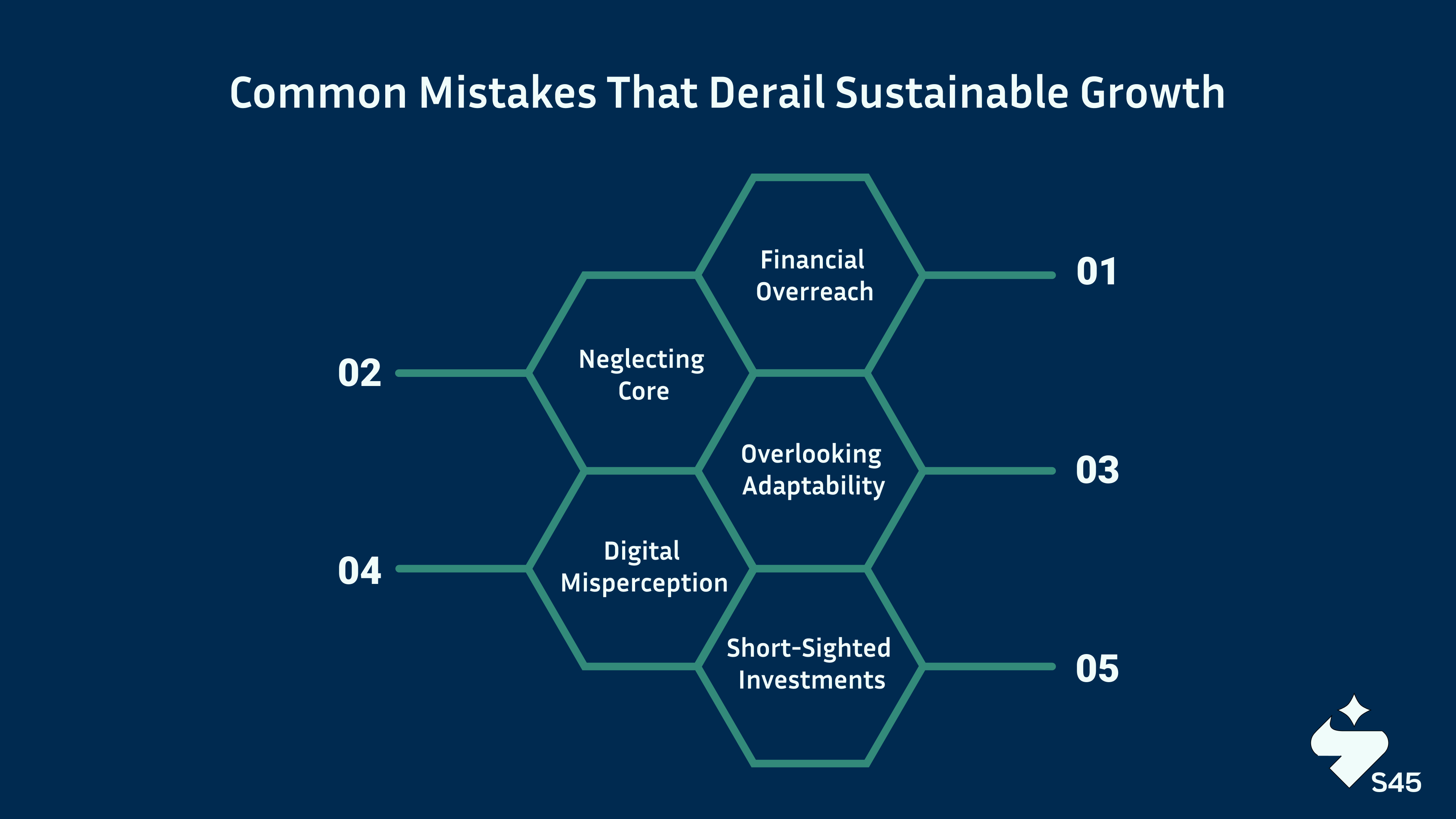
Even the best climbers make mistakes that halt their progress. In business, some errors can undo years of effort. Achieving business growth and sustainability demands discipline, self-awareness, and avoiding shortcuts that weaken your foundation.
Here are 5 mistakes that often derail sustainable business growth strategies and how you can avoid them:
1. Overusing Finances for Rapid Expansion
Many founders believe quick expansion is the ultimate measure of success. They take on large debts without a repayment plan, hoping future profits will cover them. But aggressive borrowing often reduces flexibility, limits reinvestment, and creates financial stress.
Sustainable business growth requires strong financial foundations, not risky bets. Avoid this by scaling in phases, building reserves, and funding growth through profits and strategic capital rather than excessive debt.
2. Ignoring Legacy Strengths While Chasing Trends
In the rush to modernize, some businesses abandon what made them strong. For example, a family-run textile manufacturer focusing only on trendy synthetics, ignoring its heritage in natural fabrics, risks losing loyal customers.
Sustainable growth of business builds upon your legacy while adopting innovations that enhance it.
3. Underestimating Change Management and People Readiness
Introducing new processes or technologies without preparing teams leads to resistance and underperformance. Employees feel disconnected if they do not understand the reasons behind changes.
For example, implementing ERP without proper training can cause operational chaos. Sustainable business growth demands strong change management. Engage teams early, communicate clearly, and build readiness before every transformation.
4. Viewing Digital Transformation as a Cost Rather Than an Enabler
Digital tools are often seen as unnecessary expenses, especially by traditional businesses. But treating them as costs delays efficiency gains, market responsiveness, and customer satisfaction.
For example, automating inventory can reduce errors and free up working capital. Digital transformation is a route to growth that a sustainable business truly needs. View it as an investment in resilience, not an expense.
5. Choosing Transactional Investors Over Guiding Partners
Many businesses choose investors who only provide capital, thinking funds alone will drive growth. But without strategic guidance, they often struggle to scale effectively. They miss out on valuable insights, industry experience, and practical support that could help them build stronger operations, enter new markets, and grow sustainably.
For example, a trading firm that raised funds from a general investor failed to enter new markets due to a lack of sector expertize. True business growth and sustainability come from working with partners who understand your terrain and share your vision.
Avoiding these mistakes creates a path where each step strengthens the one before it. Sustainable business growth does not mean avoiding all risks; it means taking calculated and purposeful steps that build long-term value.
Strong guidance ensures each move is strategic and safe. Now, let's see how S45 walks beside you as you scale, ensuring your growth is anchored in expertize, trust, and lasting impact.
How S45 Helps You Scale Sustainably?
At S45, we see ourselves as trusted partners guiding you through your business journey. We walk beside founders, offering guidance and support rather than giving top-down instructions. Our role is to guide your climb, using our experience to make each step purposeful and secure.
Our approach combines:
- Deep sector expertize in manufacturing and trading: We understand the operational challenges, market shifts, and cultural nuances that shape your decisions.
- Capital plus strategic guidance: Funding alone does not create lasting growth. We support your plans with insights, structured execution, and industry best practices.
- Legacy-honouring growth routes: We help you modernize while preserving what made your business valuable. Your legacy is not an obstacle; it is your foundation.
- Practical, founder-focused problem solving: Our team works at ground level, addressing day-to-day operational issues that impact growth from supply chain delays to team capability gaps.
- Club S45 community: Growth is easier when you are part of a trusted circle. Our community of founders shares knowledge, opportunities, and support so everyone progresses together.
We do not promise shortcuts. We offer routes that build sustainable growth of business, giving you the confidence to move forward with strength and clarity.
Join Club S45 today. Let us chart your route to the summit safely, sustainably, and purposefully.
Conclusion
Sustainable business growth is about more than revenue. It combines purpose, profitability, and legacy to build companies that thrive across generations. Growth without sustainability risks collapse, while sustainability without growth limits impact. Both are essential for true success.
Strategies like strengthening core operations, building financial discipline, and forging purposeful partnerships support business growth and sustainability. Avoiding mistakes such as overleveraging finances, ignoring legacy strengths, and underestimating change management ensures each step builds stability. These are not quick fixes but part of a founder's mindset for the sustainable growth of a business.
At S45, we see growth as a sustainable business, a summit worth climbing with careful planning and the right guides. Which of these sustainable business growth strategies will you prioritize first to honour your legacy and create lasting value for your business and community? Reflect and choose your next route wisely. Contact S45 today.
Frequently Asked Questions
1. What is sustainable business growth?
Sustainable business growth means expanding your business in a way that maintains profitability without harming long-term stability or values. It includes operational efficiency, responsible resource use, and building strong teams and systems to support growth that can last across market changes and future challenges.
2. Why is sustainability important for growth?
Sustainability ensures growth doesn't compromize your business's ability to serve customers in the future. It builds brand trust, attracts investors focused on responsible businesses, and strengthens internal processes. It also reduces risks from market shifts, resource shortages, or regulatory changes affecting your operations and scale.
3. What are examples of sustainable business strategies?
Examples include investing in operational efficiency and adopting digital tools to improve productivity. Developing leadership, building strong financial systems, and focusing on customer loyalty also matter. Innovating products and processes and forming partnerships that support mutual, long-term growth are key strategies for sustainability.
4. How long does it take to achieve sustainable growth?
There is no universal timeline. Foundational strengthening often takes 1–2 years. Market expansion can take 2–3 years. Global scaling or large transformations take 3–5 years or more. Sustainable growth is a multi-year journey, focusing on purposeful steps that build strong foundations at every stage.
5. How does venture capital support sustainable growth?
Venture capital supports sustainable growth by providing funds to scale quickly, combined with strategic guidance and industry connections. It helps businesses expand operations, enter new markets, and strengthen systems. However, founders must align investor expectations with long-term business goals to grow responsibly and protect stability.
